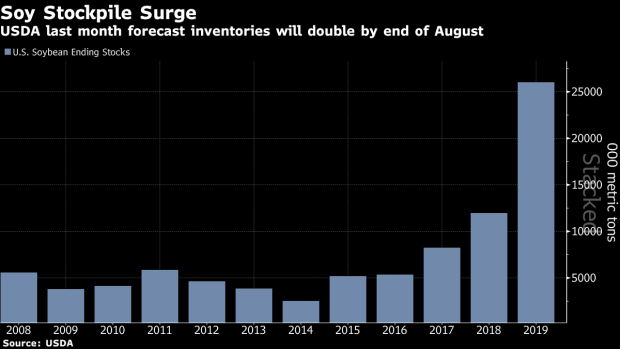Dec 13, 2018
American Prices for Soybeans and Corn Are on the Mend
, Bloomberg News

(Bloomberg) -- As China steps back into the U.S. crop markets, American prices for corn and soybeans are on the mend amid optimism over demand. At the same time, rival producers like Brazil and Canada may start to lose out if the U.S. and China are able to strike a long-term trade deal.
While reaction in the soy futures market has been muted so far as traders hold out for bigger purchases, U.S. cash prices have climbed. There’s also been a lot of action in the corn options market, while premiums for Brazilian crops have dropped.
These charts illustrate some of the changing dynamics:
The trend is reversing for American and Brazilian soy prices. When the Asian country snubbed U.S. supplies earlier this year, premiums for crops from Brazil started surging as trade flows changed. Now, cash prices for U.S. beans are recovering, and the Brazilian market is cooling off.
The average U.S. cash corn price climbed to the highest since early June, according to an index compiled by the Minneapolis Grain Exchange. As China resumes its soy purchases, some traders have said that corn may be a surprise beneficiary of the easing trade relations. Relatively low prices for U.S. corn have attracted recent buying from importers including Mexico.
The Trump administration is pushing China to make agricultural purchases beyond soybeans as part of “good faith for the discussions” to ultimately end the spat, U.S. Agriculture Department Deputy Secretary Steve Censky said on the sidelines of the Iowa Soybean Association meeting Thursday.
The party may be over for Canadian soybeans. Exports from the country reached a monthly record in October as China sought alternative sources amid its dispute with the U.S. The Canadian shipments were up 91 percent from a year earlier, government data show. There will probably be a short-term slowdown in Canadian sales to China as demand is pulled back to American soybeans and as Brazil harvests their crop, said David Reimann, a market analyst at Cargill Inc. in Winnipeg, Manitoba.
China’s return to the U.S. market hasn’t been enough to bolster soy futures so far. A huge stockpile of the crop helps explain why the market remains unimpressed. American inventories are set to double to a record 25.99 million metric tons, according to the U.S. Department of Agriculture.
On Thursday, the USDA reported sales of 1.1 million tons to China. To put the purchases in perspective, China buys 30 million to 35 million tons of U.S. soybeans in a normal year, Censky said.
“There needs to be a lot more” buying, he said.
--With assistance from Michael Roschnotti and Mario Parker.
To contact the reporters on this story: Jen Skerritt in Winnipeg at jskerritt1@bloomberg.net;Shruti Date Singh in Chicago at ssingh28@bloomberg.net
To contact the editors responsible for this story: James Attwood at jattwood3@bloomberg.net, Millie Munshi
©2018 Bloomberg L.P.


